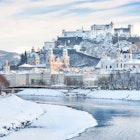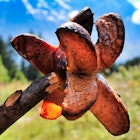
Oct 7, 2025 • 9 min read
Take advantage of this brief holiday lull to enjoy the vacation of your dreams.

Oct 7, 2025 • 9 min read
Take advantage of this brief holiday lull to enjoy the vacation of your dreams.

Sep 24, 2025 • 9 min read
You'll find exciting winter adventures in the northern hemisphere, from polar bear safaris to viewing Iceland's northern lights and so much more.

Aug 27, 2025 • 7 min read
A cabin perched on a mountain above Verbier, Switzerland, celebrates its 100th year as a friendly and safe place in a hard and unforgiving environment.

Aug 27, 2025 • 6 min read
Women-only small group adventure travel experiences are booming. Here are the best women-only hiking trips for you to enjoy in the Swiss Alps.

Jun 19, 2025 • 3 min read
Max Knight is a British photographer based in Los Angeles who recently took the Albula/Bernina train across the Swiss Alps.

May 30, 2025 • 7 min read
Switzerland is a small country with a big, efficient train network and enchanting mountain scenery. Here's our pick of the best rail routes.

Apr 17, 2025 • 6 min read
Head to Switzerland to watch 16 of the worldʻs best womenʻs soccer teams compete in the UEFA tournament.

Apr 10, 2025 • 8 min read
Plan your menu hit list with this guide to the best food and drink in Switzerland.

Jan 29, 2025 • 10 min read
Ready to be enchanted by fairy-tale towns and reach dazzling Alpline heights? Here are the best places to visit in Switzerland.

Dec 19, 2024 • 10 min read
With its world-famous trails, Switzerland has a hike to suit every mood and moment. Here we bring you nine of the country’s best hikes.

Nov 20, 2024 • 7 min read
Visiting Switzerland as a family is wonderland of adventure for all ages. Start planning now with our guide to the top things to do and where to go.

Oct 3, 2024 • 13 min read
Rafting, hiking, stargazing, art-admiring, train riding and much, much more.

Sep 10, 2024 • 8 min read
Find the best ski resorts in Valais, Switzerland, whether you're a powder fiend, all about the après, or content to meander down gentle, tree-lined slopes.

Sep 10, 2024 • 5 min read
Whether you’re looking to hike, ski, swim or sample city life, these are the best times to visit Switzerland.

Jul 29, 2024 • 6 min read
Make the most of mountain town charm, epic scenery and high-adrenaline adventures in the Swiss Alps resort of Andermatt.

May 24, 2024 • 8 min read
Traveling in scenic Switzerland is a joy. Here are the best ways to get around.

May 24, 2024 • 8 min read
Switzerland is full of incredible landscapes, and the best way to see them up close is on a road trip. Here are seven of our absolute favorites.

May 17, 2024 • 8 min read
Switzerland is one of the world’s most expensive places, it’s true. Follow these tips to get the most out of this beautiful nation for less.

May 2, 2024 • 9 min read
From biking and hiking to wildlife watching, experience the best of the Swiss Alps with this guide to the top things to do.

May 24, 2023 • 8 min read
Delve into the world of Schwingen with this guide to the why, when and where of Swiss wrestling.

Apr 24, 2023 • 3 min read
Stunning Switzerland is a joy to visit and rightly beloved by travelers, but its entry requirements aren't always obvious. Here's what you need to know.

Apr 6, 2020 • 5 min read
Last September James Gabriel Martin hiked to a cabin built 2,200 metres above sea level in the Swiss Alps to play a concert with his band Cry Monster Cry.